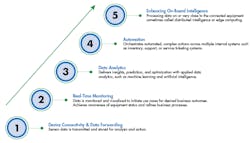Download this article in PDF format.
Just a few years ago, we were in the beginning stages of learning about the Internet of Things (IoT) and the impact it would have on engineering. Now, we have moved past that initial learning curve and are starting to implement Industrial IoT (IIoT) solutions at a rapid pace. The 2017 Annual IIoT Maturity Study from Bsquare revealed that manufacturers are adopting IIoT products and solutions at high rates, but are still at the beginning stages of advanced analytics.
The Results of IIoT First Steps
Bsquare conducted the Maturity Study to determine how companies are adopting IIoT systems and how satisfied they are with the progress. Over 300 companies with annual revenues of at least $250 million participated in the study. The companies involved were from three major industry sectors: manufacturing, transportation, and oil & gas.
The survey results showed that while many companies are excited to start IIoT projects, the actual numbers of projects initiated are still small scale. Specifically, 86% of respondents are currently adopting IIoT applications. Most are in construction and transportation (93%), closely followed by oil & gas (89%), and lastly manufacturing (77%). Roughly 84% of them believe the projects are effective, and 95% state that the IIoT projects are having a significant impact on their business. The majority of the projects (78%) are focused on connecting devices and machines, either via Ethernet or cloud services, and 83% of the projects involve data visualization.
These projects, while promising in terms of adoption rates, are still low level in terms of an IIoT system’s overall capabilities. Only 56% are using real-time data monitoring, 48% of respondents are attempting advanced analytics from the data collected, and just 28% of them are implementing automation processes based of those analytics. The most promising number of the study is that 73% of the respondents plan to increase their investments in IIoT over the next year, with their sights set on expanding the complexity of IIoT systems.
The Bsquare IIoT Maturity Index outlines the stages commonly associated with Industrial IoT technology adoption. Each phase typically builds on the previous one, allowing organizations to drive maximum value as they progress through the index. (Courtesy of Bsquare)
10 Steps for Companies Entering the IIoT Fray
Many companies are still looking at how best to start their journey into IIoT. A recent guide from Michael McEnery, Professional Engineer, and President of McEnery Automation, a system integrator company, outlined 10 steps on this process.
1. Before starting the project, ensure your company or the end user is committed to using the data. IIoT projects connect several devices to sensors and monitoring systems, collecting copious amounts of data. Making sense of the data and determining its value can take time. By finding end users who are committed to using the data, willing to assist with funding, implementing procedures to use the data, and informing management of the results, ensure your IIoT project will succeed.
2. Familiarize yourselves with common applications of IIoT. Some of the most common tools and strategies include:
- Preventive maintenance: Provide run-time or equipment cycles.
- Predictive maintenance: Provide warnings for conditions that indicate impending failure.
- Energy consumption: Provide power-consumption rates to assist in decisions to adjust equipment power usage to avoid peak-use energy penalties.
- In-line quality sensors: Provide real-time data to the quality-assurance department to reduce labor for regulatory sampling, allowing for quick reaction to quality issues with raw materials or finished products.
- Batch optimization: Provide batch data and trends to process engineers for analysis. Analytic insight can provide optimization to product production including improvements to mixing, heating, and cleaning times.
- Proportional-integral-derivative (PID) loop tuning: Time-series process data is useful for PID loop-tuning improvements, mechanical performance issues of control valves, or finding root causes of process variations.
- Inventory planning: Provide real-time inventory information to improve on scheduling, shipping, and ordering of raw materials and finished goods.
3. Having a stable and secure network is essential to having a successful IIoT system. Due to the large amount of data being collected and the increased number of users on your network, having an outdated system can hamper your growth. Focus first on two basic concepts: network segmentation and boundary protection. Consult the NIST Special Publication 800-82 “Guide to Industrial Control Systems (ICS) Security” (https://plnt.sv/1711-AZ) resource guide on how to setup your network. You may be required to hire an outside consultant or integrator.
4. Do not get distracted with the numerous buzzwords and hype created by the IIoT community. There are tools being developed all of the time, such as fog computing or edge analytics, and it can be overwhelming. Focus first on developing basic systems (e.g., network connections) and implementing sensors prior to using cloud-based servers or fog computing.
5. Reach out to your existing vendors for IIoT solutions. IIoT is an increasing business and there are several options for implementation methods, and technologies, which can make choosing one overwhelming. The benefits of working with a vendor you already know and trust will probably outweigh benefits and features offered by other software vendors.
6. Revaluating your system connections may result in the decoupling of devices and applications due to switching to IoT protocols. A software solution that accesses the field device directly and bypasses your automation control system might provide an advantage if large amounts of data are required. The data can be processed outside of your control system, and since the control system has no need for that data, may relieve some stress on the system.
7. The internet can wait. When starting your implementation of IIoT systems, connecting your application to the internet is not a priority. Many manufacturers are still operating in a closed network setting as they establish their security protocols. In addition, many manufacturing applications do not need internet access. Focus first on sharing important process data within your business network. Later on, you can figure out how to share your data securely over the internet.
8. The convergence of IT (information technology) and OT (operations technology) is fundamental to IIoT systems. This convergence will enable the secure and reliable movement of data to users and applications beyond the plant floor. Finding ways to correlate information from various business systems with the plant floor can be more challenging than alarm monitoring and trending, but it can provide great benefits. For example, combining data for raw-material costs, sales trends, inventory, and work in progress might result in more efficient production schedules or cost-saving recipe changes.
9. Transmitting the data to the end user is the goal of IIoT. Ensure that your setup provides system users with up-to-date, accurate data. Also, take the time to train the users on how to adjust the system to meet their needs based off the data, which will constantly change, as problems get resolved and new ones surface. Distill in managers to encourage their teams to use the data. Proper training and ease of access to data makes it easier for everyone to feel encouraged to use the data and prevent frustration.
10. The end goal of any IIoT system is to identify the improvements resulting from your system. Work with your users to demonstrate to the company how the IIoT is improving the bottom line. Calculate the financial benefits and share this information with those who supported your initial project funding to demonstrate how initial investments did not go to waste. This also helps to secure financial investments for developing your IIoT system in the future.


